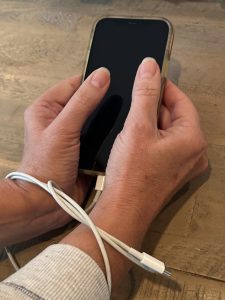Welcome back to my series on healthy technology use. Over the last few weeks, we have:
- Explored how and why companies lure users into unhealthy use patterns
- Learned the signs of technology overuse and addiction
- Identified the most problematic apps.
If you’re just tuning in now, be sure to check out Part 1 and Part 2 of this series. Today, we’re going to look at specific things you can do to limit the negative influence of technology in your life at home, work, and school:
Common Problems & Straightforward Solutions
PROBLEM: My kid is on their device ALL THE TIME and I notice that they get more irritable or anxious during those times. They’re also shirking responsibilities.
SOLUTION: Kids thrive in an environment with reasonable limits, but the tweenage/teenage brain’s braking system isn’t particularly good at setting or enforcing limits yet. That means we parents have to create the boundaries for them. With practice, your child will eventually be able to self-regulate but, during the tween and teen years, we need to help them learn that skill. Parents should set AND enforce reasonable, age-appropriate time limits utilizing built-in device controls. If the device you’re using doesn’t have this option YOU must set and enforce a limit yourself.
Teens should be limiting non-educational screen time to no more than 2 hours/day. This includes video games, social media, texting apps, YouTube. If they need access to their device for other reasons, help your child by enabling app-specific limits (eg. no gaming/social media in school, or during homework/family times), setting rules about where to store and charge their phone overnight (eg. NOT in their bedroom), and in extreme circumstances, you may need to confiscate phone/laptops/tablets after a certain time and turn off WiFi.
If your kid is having trouble completing their chores/homework because of their device, consider using screen time or certain app time as a reward for completing other important tasks. The Premack Principle says that we are more likely to complete a less desirable task if we know we will get to do a more desirable task once the boring/unpleasant task is completed. So, tell your kid that once they clean their room, they can have have 30 minutes on YouTube.
PROBLEM: I need social media to keep up with what my friends are doing, but it often makes me feel bad when I’m left out or don’t measure up.
SOLUTION: Be intentional with who you follow and why. Follow what makes you feel good. If you find that someone’s posts are consistently leaving you with a bad feeling, unfollow or mute them for a while. By not interacting with their page, you will reset the algorithm and see less of them in your feed. That may be enough of a reprieve. However, if you find it irritating to see even a little bit of their content, then ask yourself why you’re following them to begin with. What do you gain with that connection? If the gain is worth a little discomfort — for example, they represent an opposing view that you’re interested in understanding even if you don’t agree with it — then keep following them, but you might want to work on de-personalizing or de-catastrophizing your reaction to their content. If the pro-con list for that person ends up with mostly cons, then unfollow/unfriend them. Sometimes, it’s just not worth it.
In the case of feeling left out or less than, remember that you probably have different types of friends in your social media community: acquaintances, familiar friends, and ride-or-die friends. Each of these relationships address a specific and important need in your life. It’s a common mistake to apply the expectations for one friend category to another category. (For example, you wouldn’t expect an acquaintance to understand what makes you feel vulnerable because they don’t know you well enough to know your history, but you might still have a strong reaction to something they post that feels very triggering for you.) Unfortunately, friendship lines often get blurred on social media, but we need to keep these categories in mind because it will change how we feel about what we see. What we think affects how we feel and how we feel affects how we behave. If we think differently about the content we are seeing, we WILL feel differently about it as well.
If it’s a person’s comments on your posts that leave you uncomfortable, mute them! Instagram allows you to do this without unfollowing or blocking them entirely. This Instagram feature makes it so they can comment, but no one else including you can see their comment. From their vantage point, they commented but no one responded to them. Many other apps enable you to define a specific audience for your posts so you only get feedback from those you want. However, if you’re not looking for engagement with your post, you may want to ask yourself why you’re posting it at all. And, if you don’t want to listen to a particular person’s opinion, then ask yourself why they’re in your social media circle to begin with. If you can’t ditch the connection, then change the audience you have them in and be mindful of your audience when you post.
It’s easy to fall into the trap of comparing our real lives to the curated version of others’ lives we see on social media. This is a mistake – no one’s life is perfect and perfectly lit all the time! So, when do you call someone out? If your BFF’s posts leave you feeling left out or less than, by all means, discuss it with them (in person) because you likely have a relationship built on trust, honesty, and vulnerability and they will want to know they’re hurting your feelings. But, if an acquaintance posts something that makes you wish some aspect of your life was different, rather than feeling jealous of them or bad about yourself, get inspired. How can you and your closer friend group create a similar experience?
PROBLEM: I have to use apps several hours a day for school or work and it leaves me feeling stressed, strained, or overwhelmed.
SOLUTION: Talk to your teacher or boss. Let them know that you are working hard to curb your technology use and see if there are alternatives methods for you to complete/submit your work or interact with your peers.
For students, ask if you can submit hard copies of your work and obtain handwritten feedback or discuss feedback in a conference with your teacher. If your school allows students to have phones in classrooms – a lot of them do – ask your teacher to enforce a silent phone policy to help you focus. Remember, some technology use can improve your educational experience. For example, if you are working on a group project try using FaceTime or another group meet up app rather than working at home in isolation. This will create cohesion, accountability, and better flow of ideas.
For workers, see if you can address the urgency culture by setting a “business hours only” limit for sending emails/text (you can now set a scheduled send time in most apps) and establish a workplace norm that allows for 24-48 hour response time unless there is an *URGENT* indication on the note. Also, try setting a “no-phones” or “silent phones only” policy during face-to-face meetings. It might be more efficient to handle an issue over group text, but you will likely miss important details or jeopardize workplace cohesion and increase peer competition. Try a quick GoogleMeet or Zoom instead. This way, you can see and read body language and pick up on vocal tones. This won’t work in every situation, but the more you do it, the more value your workplace will place on this type of interaction. Prioritizing face-to-face interaction is a really important step in resetting unhealthy technology use behaviors. And, if you’re trying to implement healthier use at home, the continuity of holding yourself to the same standard at work will support you in meeting this goal.
NOTE: These changes need to be modeled and praised by those in leadership positions to effectively change workplace culture.
PROBLEM: My phone is the first thing I see in the morning and the last thing I see before bed.
SOLUTION: Do not use your phone as an alarm clock. Having your phone nearby just increases the chances that you will rely on it even when you don’t need to. Studies consistently show that even with a blue light filter phones and other devices negatively impact sleep. If you are in the habit of falling asleep watching a screen, try reading a book or listening to a podcast or meditation app instead. Start your sleep routine about 1 hour before you need to go to sleep to allow your brain to associate new behaviors with winding down for the day. Try taking a bath, using lavender spray on your pillow, and listening to a white noise machine. By activating your other senses in a combined way, you will achieve a calming effect that is more conducive to sleep.
PROBLEM: I feel very anxious without my phone!
SOLUTION: You’ve simply gotten used to having your phone with you 24/7 and Big Tech LOVES that! That’s what they want. The more connected you are to your phone the more money they make. So, to outsmart them, be intentional about building screen-free times into your day. Consider eating your lunch with your peers and leave your phone in the office or your locker. Go for a walk outdoors without your phone. “Green therapy” has been shown to reset the dopaminergic effect in the brain. The fresh air, the sights and sounds of nature, and the physical movement cause our bodies to release the other hormones associated with happiness: oxytocin, serotonin, and endorphin. The more you practice leaving your phone behind the easier it gets to maintain. You teach people that they may need to wait a bit to hear from you and you learn that the world doesn’t end if you make people wait a bit to hear from you. It takes about 30 days to make or break a habit. You can anything for 30 days…right?
PROBLEM: My phone is always distracting me from what I need to do.
SOLUTION: Turn off notifications on all apps or opt for summary notifications at set times. Set reminders to check for updates 2-3 times a day. If that’s not workable for your job, then set maybe 5 minutes each hour to review emails, posts, and texts. Respond to what feels urgent and leave the rest for later. If you wait to reply, you might find that a response isn’t necessary anyway. By giving yourself some time tho think about it, you will also be more likely to craft a thoughtful (i.e. less impulsive or reactive) response.
3 Special Tips for Parents
Parents have a lot of influence on the way their kids think about challenging situations. We are our kids’ first (and can be their best) teacher when it comes to learning how to handle the difficult things in life. Parents should model healthy use following the same rules they expect their kids to follow. They should talk openly about their own challenges and successes with self-regulation on the Internet. The more regularly parents focus on helping kids develop Internet maturity, the better their child will get at holding themselves to this standard as well. How will you know when you’ve been successful? Once your child demonstrates these 3 skills consistently, you can feel fairly comfortable easing up on supervision:
- The ability to think critically about the content they are exposed to (not just about the intentions of the source or the validity of the message, but how it makes them feel)
- The ability to self-regulate their Internet use and overall screen time (with the intention of minimizing sleep loss, safety concerns, interference with responsibilities, and fights)
- The ability to use all forms of the Internet, social media, and screen time for good
What’s the bottom line?
It’s not practical to think we can quit our screens altogether. Social media and the Internet are woven into the fabric of our daily lives much like public utilities and they aren’t going anywhere even if they take different forms as new companies reinvent the concept. Next year, we’ll probably be talking about a new attention-seeking technology that we can’t even fathom today. That’s why it’s important to have specific, practical, and sustainable skills in place that shield us from the negative impacts of technology in general rather than trying to figure out how to handle one specific app.
For More Information:
If you’re concerned about your or your child’s technology use and you’ve tried unsuccessfully to make reasonable changes, please seek support from a mental health professional. And, be sure to revisit Part 1 or Part 2 of this series if you’re looking to implement a comprehensive plan at home.




